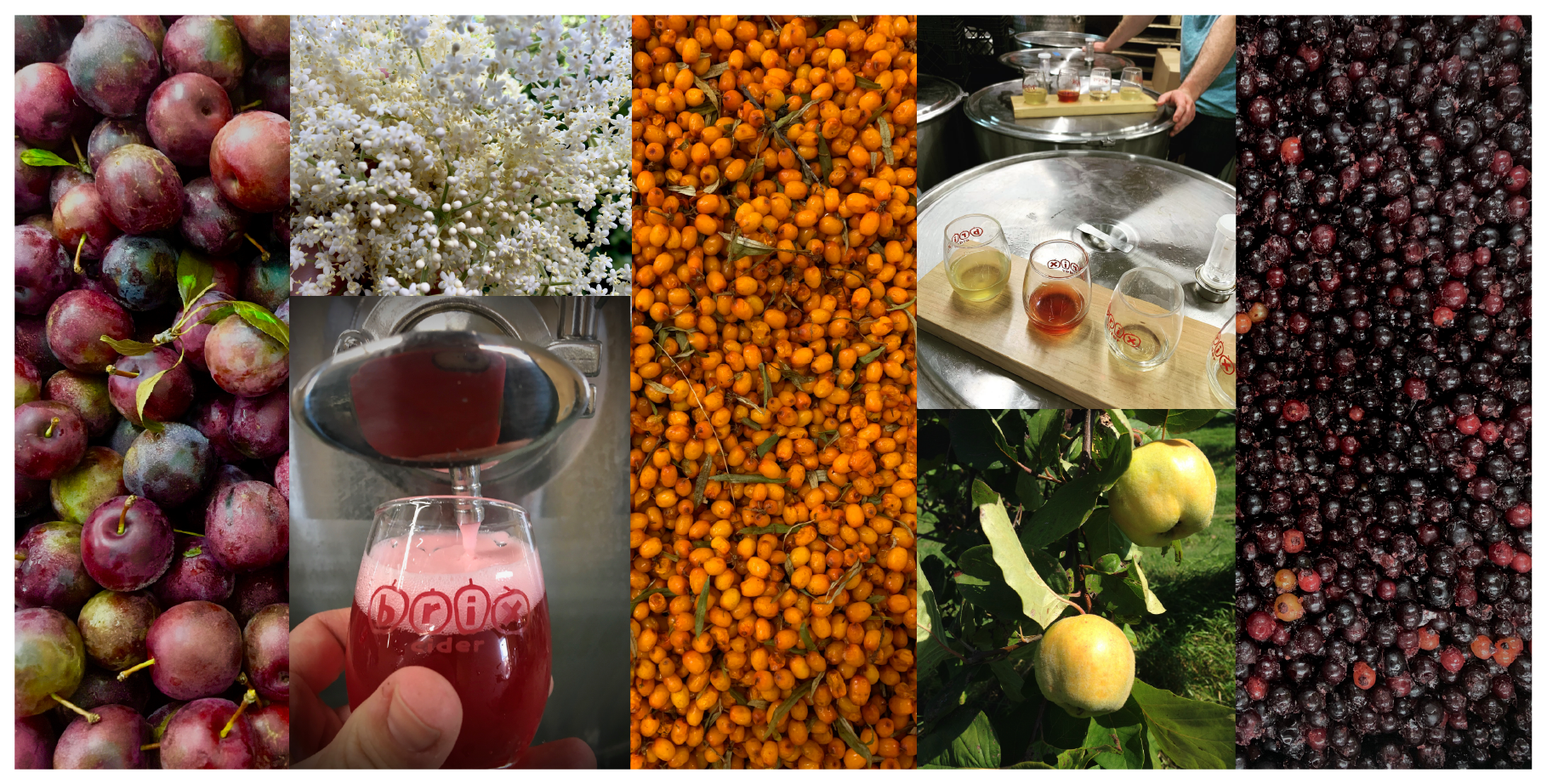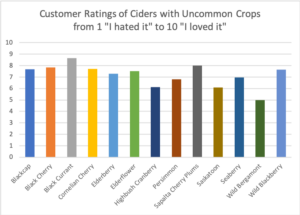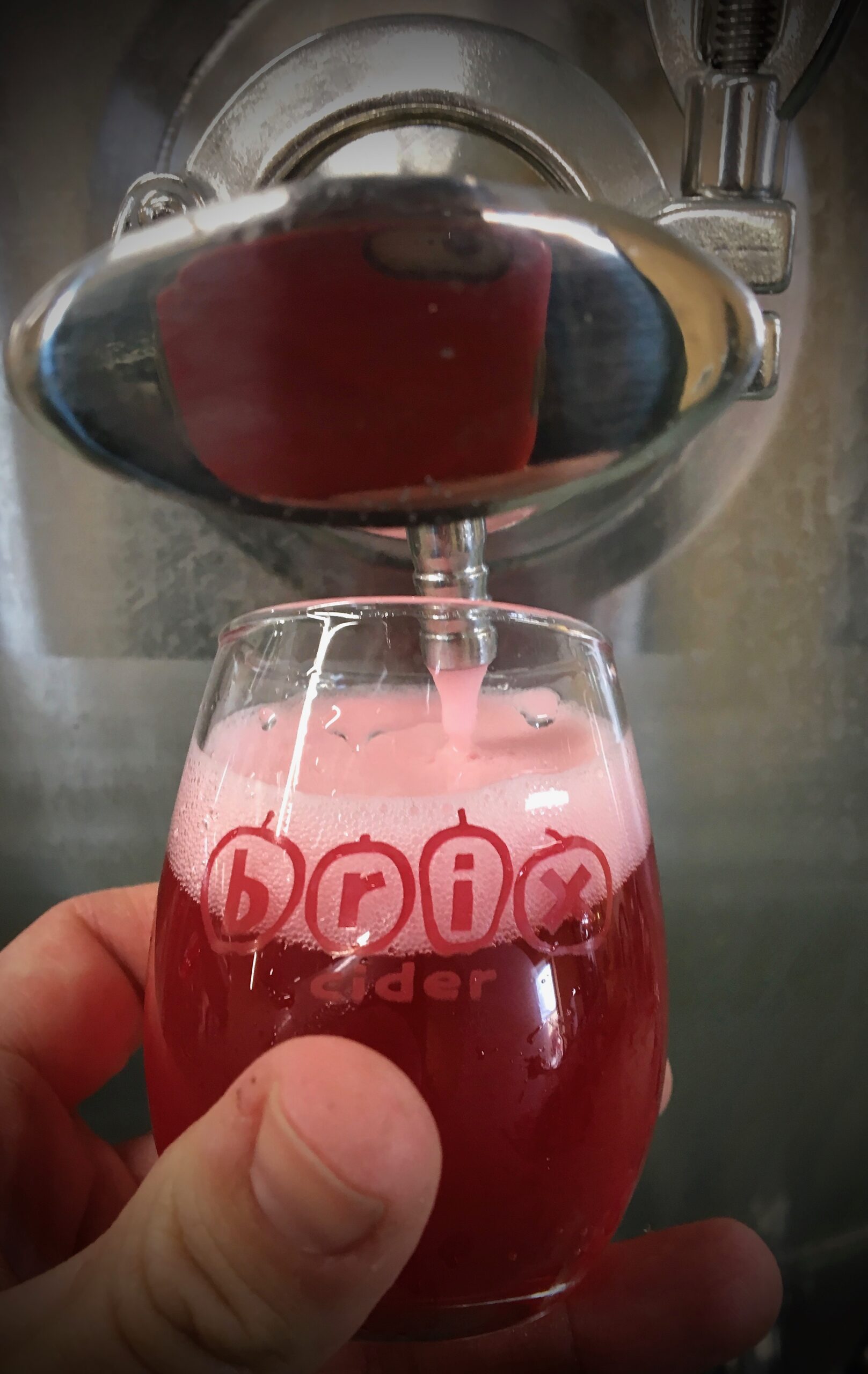Final report for FNC19-1189
Project Information
This project included Brix Cider, Carandale Fruit Farm, Blind Giant Farm, and Lehman Family Farm. Brix Cider has a 25 acre farm where they are planting a variety of fruit crops with a focus on apples for their hard cider business. They also harvest and purchase apples and other fruit from several other local orchards for the hard cider business. Carandale Fruit Farm specializes in strawberries. They also grow aronia berries and black currants, and they have an experimental plot where they are growing dozens of uncommon fruit crops. Blind Giant Farm has a large garden, a sugar bush, and 40 acres of foraging land. Lehman Family Farms is a 120 acre farm where Abbie Lehman has started foraging professionally after years of passionate interest.
 Uncommon perennial fruits and wild crafted products offer unique sustainability potential, but limited information about their potential uses makes them difficult crops to market. This project evaluated the potential of 13 uncommon crops and wild crafted products for use in the craft beverage industry. The project’s experienced team of farmers and researchers developed test batches (approximately 50 gallons each) of hard cider-based products that incorporated blackcap, black cherry, black currant, cornelian cherry, elderberry, elderflower, highbush cranberry, persimmon, sapalta cherry plums, saskatoon, seaberry, wild bergamot, and wild blackberry.
Uncommon perennial fruits and wild crafted products offer unique sustainability potential, but limited information about their potential uses makes them difficult crops to market. This project evaluated the potential of 13 uncommon crops and wild crafted products for use in the craft beverage industry. The project’s experienced team of farmers and researchers developed test batches (approximately 50 gallons each) of hard cider-based products that incorporated blackcap, black cherry, black currant, cornelian cherry, elderberry, elderflower, highbush cranberry, persimmon, sapalta cherry plums, saskatoon, seaberry, wild bergamot, and wild blackberry.
An estimated 1,000 consumers were able to try the ciders made with uncommon crops in the Brix Cider tasting room in Mount Horeb, WI. Throughout the project we also did multiple social media posts about all of the different uncommon crops and the ciders that were made from them, and these educational posts reached over 5,000 people. Brix Cider also surveyed customers to determine which ciders were the most popular, and we conducted a focus group tasting with craft beverage makers and farmers to evaluate and describe each of the ciders.
Results of the study were then posted online at https://brixcider.com/uncommon-crops-uncommon-beverages . In addition to summary results, each crop was given its own page that included a background about the crop, information about growing for foraging the crop, notes on how the project cider was made, a description of the evaluation of the cider, and a conclusion about the overall potential of each crop for further use, particularly in the craft beverage industry. In just a couple of days after posting the study, we saw over 300 visitors on the webpage, and we expect to see dozens of visitors per month in the years ahead based on traffic to other, similar pages on our website.
Based on the results of this study, we are planning to plant more of some of the successful crops in this coming spring planting season at the Brix Cider farm, and we expect to continue to work with Carandale Fruit Farm, some foraging partners, and other farms in sourcing more of the crops that we liked for making larger sized commercial batches of cider in the future. We have already started doing larger batches of black currant cider (the most popular in our consumer tasting survey), and we forged a sourcing relationship with another local farm for larger quantities of black currants. We hope that by sharing our results online that we will inspire other growers and craft beverage producers to experiment as well, using our work as a jumping off point.
The overall goal of this project was to assess the feasibility of expanding markets for 13 perennial crops and foraged plants through the craft beverage industry. Under this goal, we have the following objectives:
- Produce 13X50 gallon test batches of hard cider that incorporate each the uncommon crops
- Assess consumer perceptions of the finished products through consumer surveys
- Conduct a focus group tasting evaluation to include craft beverage producers and farmers
- Develop qualitative descriptions of challenges and opportunities related to each crop
- Disseminate findings through online informational materials
Cooperators
- - Producer
- - Producer
Research
We set out to explore 13 uncommon perennial crops that might have potential for greater use by local farmers, potential for environmental sustainability, and possible new market opportunities in the craft beverage industry based on their flavor profiles. We made small (approximately 50 gallon) batches of hard cider that each included one of the uncommon crops. We took notes on all the batches. We conducted an online survey of consumers to see which ones they liked. We assessed the batches with a tasting panel that included farmers and other craft beverage producers. We tapped our growers’ existing knowledge and research about each crop, and we put together a report to share our findings.
Our methods were not highly scientific. Each batch was made differently, and each batch had different apples as a base for the cider. We tried to work with what each uncommon crop gave us in terms of flavor profiles, and we tried to incorporate the crops into the ciders in practical ways that would also extract color and flavor. We often did not know exactly how each crop would interact with the cider, and we learned some things as we went. In spite of the lack of intense scientific rigor (and some wrenches that COVID through into our original plans as this project unfolded), we think growers of uncommon crops and other craft beverage producers will find some insights in looking at the results of our study.
All of the crops were either grown or foraged locally. The uncommon crops that we worked with included the following:
Blackcap
Black Cherry
Black Currant
Cornelian Cherry
Elderberry
Elderflower
Highbush Cranberry
Persimmon
Sapalta Plums
Saskatoon
Seaberry
Wild Bergamont
Wild Blackberry
The ciders were not all made at the same time, and they were done over the course of two years. We featured the ciders, usually one or two at a time, in Brix Cider’s tasting room in Mount Horeb, WI, alongside other ciders on tap, and we collected informal customer feedback throughout the process. We also put out educational social media posts with each of the uncommon crop ciders that we made. After the last ciders were produced, we also put out a survey to customers where they simply rated the ciders from 1 “I hated it” to 10 “I loved it.” We didn’t have a large survey response (only 25 customers), but we do think that those 25 responses represent committed customers who really paid attention to the ciders through the course of the study. We also did a focus group tasting with farmers and craft beverage producers where several of the ciders were evaluated in more depth, and each taster recorded their descriptions.
Over the course of the project, we estimate that over 1,000 customers came in and tried a cider made with an uncommon crop that they had never tried before, and we estimate that over 5,000 individuals read our educational social media posts about the different uncommon crops and the ciders we made with them. In this way we were opening people up and exposing them to new possibilities and educating them about uncommon perennial crops.
Results of the customer tasting survey are included in the graph below.
Of course the above graph does not accurately capture the potential of each crop as it doesn’t factor in how the cider was made, how a future drink could be made differently, or the horticultural potential of each plant in local agroecosystems. That said, it is a simple point to jump off from.
We wrote up more detailed descriptions of our analysis of each crop and posted them on our website here:https://brixcider.com/uncommon-crops-uncommon-beverages
Several of the uncommon perennial crops in this project showed real potential, and we hope this project inspires some growers, craft beverage producers, chefs, gardeners, and cooks to experiment with them as well. Many of the flavors were unique and in some cases potent a little can go a long way. There are certainly many more delicious things to be made and tried, and to us it’s far more interesting to step outside of the same old common crops and flavors to try something new, especially when some of these crops, being perennial in nature, have the potential to be grown in ways that protect our topsoil and support biodiversity.
Educational & Outreach Activities
Participation Summary:
Throughout the project we shared educational social media posts about each of the uncommon crops, the ciders we made with them, and the potential benefits of a more perennial and diversified agricultural system. With over 4,000 Facebook followers and over 2,500 followers on Instagram, we estimate that these posts reached over 5,000 individuals.
We also described each of these crops to bartenders at Brix Cider so that they would have knowledge about each crop that they could then share with customers as they came in to try the ciders. We estimate that over 1,000 individuals tried ciders made with uncommon fruit and in the process, they were exposed to a new perennial crop that may have never tried before.
A couple of days before completing this report, we also shared the overall findings on our website, including summary results and links to pages for each of the uncommon crops. In just 2 days, we had over 300 individuals visit the webpage, reading the results and exploring the different crop descriptions and analyses. We anticipate that the webpage will continue to get dozens of hits every month in the years going forward thus providing information for hundreds of people each year. The website is here: https://brixcider.com/uncommon-crops-uncommon-beverages
Learning Outcomes
We learned that some of the uncommon crops really do have potential for greater use in food processing like craft beverage production. Some of them offered intense and unique flavor and aroma profiles that brought an otherwise boring cider to life.
In particular, we like black currant, and we started doing larger, regular batches of it, sourcing from another local farm that is growing larger quantities of black currants. Another crop that we were excited about was Sapalta cherry plums, and we're planning to plant some at our own orchard. We also liked the potential of seaberries, especially when we realized that we could use whole branches with leaves since this reduced the labor burden of picking so many tiny berries on thorny branches.
We also learned that some of the foraged crops, namely blackcap, black cherry, and wild blackberry make a great cider, but the prospects of foraging them in larger quantities would be daunting. That said, we're considering options for a "community foraged" cider wherein we use a crop like blackcaps sourced from a large number of individual volunteers, making it a fun, social cider.
Lastly, we learned that there were a couple of the uncommon crops that really didn't work particularly well at least in the ciders as we made them. The saskatoon proved a little too mild to really come through in a cider, and the wild bergamot was a little too odd and planty tasting.
Project Outcomes
Black currants were one of the first uncommon crops that we tested in this project. We started with a small batch, and we really loved the beautiful color and rich flavor that the black currants lended to the cider. We then found another nearby farmer who grows black currants in larger quantities, and we started regularly sourcing from him. Our Black Currant Cider is now a standby that we regularly feature, and it's a customer favorite.
Overall this was a fun project, and I think it was a great way to expose people to potential new diversity of perennial plants. Some of our original plans were foiled by an odd cropping year for some of the crops in the first year of the project and then by COVID. We may not have carried out all the work as originally planned, but we think the project still had a lot of value. We're planning to continue exploring additional uncommon crops and sourcing some of the ones we liked from this project even without another grant!
Information Products
- Uncommon Crops Uncommon Beverages (Website)

